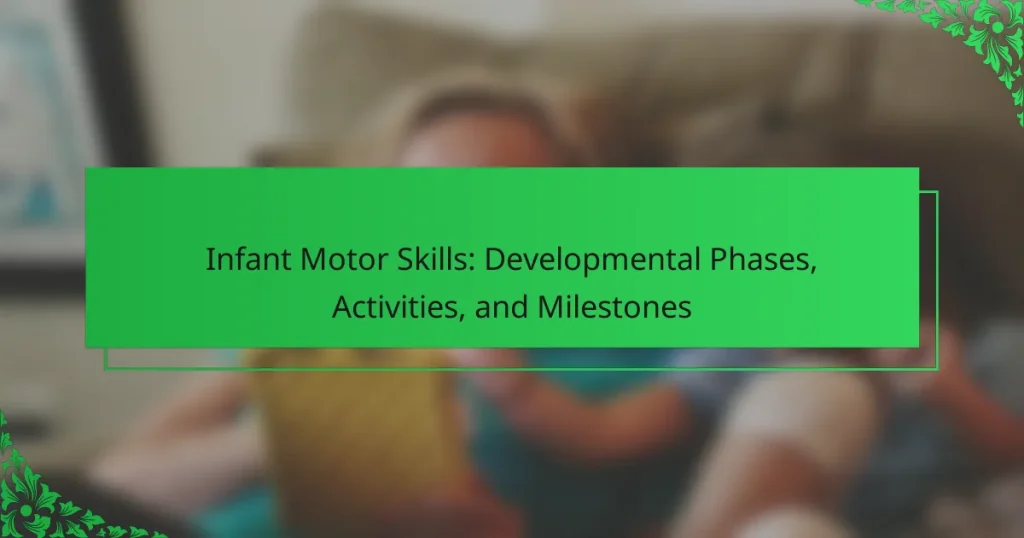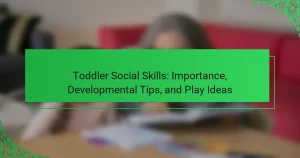
What are Infant Motor Skills?
Infant motor skills are the abilities that allow infants to control their body movements. These skills develop as infants grow and interact with their environment. They can be categorized into two main types: gross motor skills and fine motor skills. Gross motor skills involve large muscle movements, such as crawling and walking. Fine motor skills involve smaller movements, like grasping objects and manipulating toys.
Research shows that motor skill development is crucial for overall growth and coordination. According to the Centers for Disease Control and Prevention (CDC), infants typically begin to show gross motor skills by 3 to 6 months, such as rolling over. Fine motor skills usually emerge around 6 to 9 months, with infants learning to pick up small objects. These milestones are essential for later physical and cognitive development.
Why are Infant Motor Skills important for development?
Infant motor skills are crucial for development as they lay the foundation for physical and cognitive growth. These skills enable infants to explore their environment, which is essential for learning. Mastery of motor skills promotes independence, allowing infants to interact with objects and people. Research indicates that infants with advanced motor skills often demonstrate better problem-solving abilities. Additionally, motor skills are linked to social development, as they facilitate play and interaction with peers. The development of these skills also supports sensory integration, helping infants process information from their surroundings effectively. Overall, strong motor skills contribute to a child’s overall developmental trajectory.
How do Infant Motor Skills impact overall growth?
Infant motor skills significantly impact overall growth. These skills are crucial for physical development and coordination. They enable infants to explore their environment, which stimulates cognitive growth. Improved motor skills promote muscle strength and coordination. This, in turn, supports milestones such as crawling and walking. Research shows that infants with strong motor skills often demonstrate better social and emotional development. A study by Adolph and Robinson (2015) highlights the connection between motor skills and cognitive abilities. Therefore, developing motor skills is essential for holistic growth in infants.
What role do Infant Motor Skills play in cognitive development?
Infant motor skills play a crucial role in cognitive development. These skills involve the physical movements and coordination that infants develop as they grow. As infants practice motor skills, they explore their environment. This exploration enhances their understanding of spatial relationships and object permanence. Research indicates that motor development is linked to cognitive milestones. For example, infants who crawl may develop better problem-solving abilities. Engaging in activities that promote motor skills can stimulate cognitive growth. Studies show that infants who are active in their movements tend to have advanced cognitive skills later on. Thus, motor skills are foundational for cognitive development in infants.
What are the different types of Infant Motor Skills?
The different types of infant motor skills include gross motor skills and fine motor skills. Gross motor skills involve large muscle movements. These skills include actions like crawling, standing, and walking. Fine motor skills involve smaller muscle movements. These skills include actions like grasping, reaching, and manipulating objects. Both types of motor skills are crucial for an infant’s overall development. Research indicates that gross motor skills typically develop before fine motor skills. The progression of these skills is a key indicator of developmental milestones in infants.
What are gross motor skills and how do they develop?
Gross motor skills are movements that involve large muscle groups. These skills include actions like crawling, walking, running, and jumping. They develop through a series of stages as infants grow. Initially, infants gain control of their head and neck. This is followed by rolling over and sitting up. As they progress, they begin to crawl and eventually walk. Activities such as tummy time and play encourage this development. Research shows that physical activity promotes gross motor skill advancement. Studies indicate that regular practice leads to improved coordination and strength.
What are fine motor skills and their significance?
Fine motor skills are the abilities that involve the coordination of small muscles in movements. These skills are crucial for tasks such as writing, buttoning clothes, and using utensils. Fine motor skills develop as infants engage in activities that require hand-eye coordination. They are significant because they contribute to a child’s overall development and independence. Proficiency in fine motor skills is linked to cognitive development and academic success. Research indicates that strong fine motor skills can enhance problem-solving abilities. Developing these skills early can lead to better social interactions and self-esteem in children.

What are the developmental phases of Infant Motor Skills?
Infant motor skills develop through distinct phases. These phases include reflexive movements, gross motor skills, and fine motor skills. Reflexive movements occur from birth to about two months. During this phase, infants exhibit automatic responses to stimuli. Gross motor skills develop from two months to twelve months. This phase involves movements like rolling over, sitting up, and crawling. Fine motor skills begin to emerge around three months. Infants start to grasp objects and manipulate them with increasing precision. By twelve months, many infants can stand and walk independently. Each phase builds upon the previous one, demonstrating a progression in physical capabilities.
What are the key milestones in the first year?
The key milestones in the first year of infant motor skills development include several critical stages. At around 2 months, infants begin to lift their heads while lying on their stomachs. By 4 months, they can push down on their legs when their feet are on a hard surface. At 6 months, many infants can sit without support. By 9 months, they typically start crawling. Around 10 months, infants can pull themselves up to stand. By their first birthday, most can take a few steps independently. These milestones are supported by developmental research, indicating typical progression in motor skills during infancy.
How does motor skill development progress from birth to 3 months?
Motor skill development progresses rapidly from birth to 3 months. In the first month, infants exhibit reflexive movements. These include grasping and rooting reflexes. By two months, they begin to gain better head control. Infants can typically lift their heads when lying on their stomachs. At three months, they show improved coordination. They can push down on their legs when feet are on a hard surface. These milestones indicate the growth of both gross and fine motor skills. Research shows that these developments are crucial for later motor abilities.
What changes occur from 4 to 6 months in motor skill development?
From 4 to 6 months, significant advancements in motor skill development occur. Infants begin to demonstrate improved head and neck control. They can typically roll over from front to back and vice versa. At this stage, they also start to sit with support. Hand-eye coordination enhances, allowing for better grasping of objects. Infants may begin to reach for toys and bring them to their mouths. These changes are supported by the development of muscle strength and coordination. Research indicates that these milestones are essential for future motor skills, laying the groundwork for crawling and walking.
What milestones should be observed in the second year?
In the second year, key milestones include walking independently, climbing furniture, and beginning to run. Infants typically take their first steps around 12 months. By 14 to 15 months, most can walk well without support. Climbing skills emerge as they explore their environment, often starting around 12 to 18 months. Running usually begins between 18 to 24 months, showcasing increased coordination. Additionally, toddlers start to kick and throw balls by 18 months. Fine motor skills also progress, with many able to stack blocks by 15 months. These milestones are crucial for assessing overall motor development in infants.
How do motor skills typically progress from 12 to 18 months?
From 12 to 18 months, motor skills typically advance significantly. At 12 months, infants often begin to stand independently and may take their first steps. By 15 months, many can walk well and start to climb furniture. They also begin to use their hands more purposefully, such as pointing or stacking blocks. By 18 months, toddlers can walk confidently and may even run short distances. Fine motor skills improve as they learn to scribble and manipulate small objects. This progression is supported by developmental milestones observed in pediatric studies, indicating that most children reach these skills within this age range.
What are the expected developments from 18 to 24 months?
From 18 to 24 months, toddlers typically exhibit significant advancements in motor skills. They often begin to walk independently and may run with improved coordination. Fine motor skills also develop, allowing them to stack blocks and manipulate small objects. At this stage, they can throw a ball and may start kicking it. They also begin to climb furniture and navigate stairs with assistance. These milestones reflect the growth of both gross and fine motor skills. Research indicates that these developments are crucial for overall physical coordination and spatial awareness.

What activities can support the development of Infant Motor Skills?
Activities that support the development of infant motor skills include tummy time, reaching for toys, and crawling. Tummy time encourages infants to lift their heads and strengthen neck and shoulder muscles. Reaching for toys promotes hand-eye coordination and fine motor skills. Crawling helps develop coordination and balance. Other beneficial activities include grasping objects and engaging in interactive play. These activities stimulate muscle development and enhance overall motor skills. Research indicates that regular engagement in these activities can significantly improve infants’ motor development milestones.
How can parents encourage gross motor skills in infants?
Parents can encourage gross motor skills in infants by providing ample opportunities for movement. Tummy time is essential as it strengthens neck and shoulder muscles. Allowing infants to roll, crawl, and explore encourages coordination and balance. Engaging in playful activities like reaching for toys helps develop arm and leg strength. Creating safe spaces for movement allows infants to practice skills freely. Supporting standing and cruising along furniture builds confidence and stability. Regular outdoor play exposes infants to varied surfaces and environments. Research indicates that active play significantly contributes to motor skill development in early childhood.
What types of play promote crawling and walking?
Interactive play promotes crawling and walking in infants. Activities like tummy time encourage muscle strength in the arms, back, and neck. This muscle development is crucial for crawling. Toys that encourage reaching and grasping also motivate movement. Push toys provide support and encourage infants to practice standing and walking. Floor play with varied textures stimulates exploration and movement. Social play with caregivers motivates infants to move toward them. These types of play foster essential motor skills necessary for crawling and walking.
How can outdoor activities enhance gross motor development?
Outdoor activities enhance gross motor development by promoting physical movement and coordination. Engaging in activities like running, climbing, and jumping strengthens large muscle groups. These movements improve balance and spatial awareness. Research indicates that children who participate in outdoor play show better motor skills. A study by the University of California found that outdoor play increases physical fitness levels. Regular outdoor activities also encourage social interaction, which can further support motor skills through cooperative play. Overall, outdoor activities provide essential opportunities for infants to develop their gross motor abilities effectively.
What fine motor activities are beneficial for infants?
Fine motor activities beneficial for infants include grasping small objects, finger painting, and stacking blocks. Grasping small objects helps infants develop hand-eye coordination. Finger painting encourages creativity and tactile exploration. Stacking blocks enhances dexterity and spatial awareness. These activities are essential for strengthening the muscles in the hands and fingers. Engaging in such activities promotes cognitive development as well. Research shows that fine motor skills are linked to later academic success. Therefore, incorporating these activities into playtime is crucial for infants’ overall development.
How do simple toys aid in fine motor skill development?
Simple toys aid in fine motor skill development by encouraging hand-eye coordination and dexterity. Toys like blocks, puzzles, and stacking rings require infants to grasp, manipulate, and position objects. This interaction strengthens the small muscles in their hands and fingers. Research shows that engaging with simple toys can improve grip strength and precision. For example, a study published in the Journal of Pediatric Therapy found that children who played with manipulative toys exhibited better fine motor skills. Additionally, these toys promote problem-solving and cognitive skills as infants learn to navigate tasks. Overall, simple toys provide essential opportunities for practice and skill refinement in fine motor development.
What household items can be used for fine motor practice?
Household items that can be used for fine motor practice include buttons, straws, and cotton balls. Buttons can be threaded onto strings or used in sorting activities. Straws can be cut and manipulated for grasping and bending exercises. Cotton balls can be picked up with tweezers or fingers, enhancing grip strength. Other useful items are paper clips, which can be opened and closed, and small containers for transferring objects. These activities engage infants and toddlers, promoting dexterity and coordination in a playful manner.

How can parents track and support their infant’s motor skill milestones?
Parents can track and support their infant’s motor skill milestones by observing specific developmental stages. Infants typically reach key milestones such as rolling over, sitting up, crawling, and walking within certain age ranges. For example, most infants roll over by six months and begin crawling around eight to ten months.
To support these skills, parents can engage in activities that encourage movement. Tummy time is crucial for strengthening neck and shoulder muscles. Providing toys that promote reaching and grasping can also aid development.
Tracking milestones can be done by maintaining a developmental checklist or using apps designed for this purpose. Regular check-ups with pediatricians can provide professional insights and assessments. Research indicates that early interventions can significantly enhance motor skill development, making parental support vital.
What are some common signs of motor skill delays?
Common signs of motor skill delays include difficulty in reaching for objects. Infants may struggle to grasp toys or manipulate them effectively. They might also show limited ability to roll over or sit up independently. Delayed crawling is another indicator of motor skill challenges. Some infants may have trouble standing or walking at the expected age. Additionally, they may exhibit a lack of coordination in movements. These signs can be observed as infants fail to meet developmental milestones. Early intervention is crucial for addressing these delays.
How can parents assess their child’s motor skill development?
Parents can assess their child’s motor skill development by observing specific milestones. These milestones include reaching, grasping, and crawling. Parents should track their child’s ability to sit up independently and walk. Noticing how well a child can manipulate objects is also crucial. For example, a child should be able to stack blocks or use a spoon by a certain age. Additionally, parents can use checklists provided by pediatricians or developmental resources. These tools outline expected skills for different age ranges. Regular check-ups with a pediatrician can also provide insights into motor skill development. According to the CDC, milestones are categorized by age, helping parents gauge progress.
What steps should be taken if delays are noticed?
If delays in infant motor skills are noticed, consult a pediatrician immediately. Early intervention is crucial for addressing potential developmental issues. The pediatrician may conduct assessments to evaluate the child’s motor skills. They might recommend physical therapy or specialized activities to support development. Monitoring the infant’s progress regularly is essential. Parents should engage in play that encourages movement and coordination. Documenting milestones can help track improvements over time. Seeking support from specialists can provide tailored strategies for development.
What tips can parents use to foster motor skill development effectively?
Engaging infants in a variety of physical activities fosters motor skill development effectively. Parents should encourage tummy time to strengthen neck and shoulder muscles. Providing age-appropriate toys promotes reaching and grasping skills. Activities like crawling and walking enhance coordination and balance. Playing with balls can improve hand-eye coordination. Dancing or moving to music encourages rhythm and body awareness. Outdoor play allows for exploration and gross motor skill practice. Regular interaction and playtime support overall physical and cognitive development. Research shows that active play contributes significantly to motor skills in early childhood.
How can routine activities be adapted to promote motor skills?
Routine activities can be adapted to promote motor skills by incorporating specific movements and challenges. For instance, parents can modify playtime by including toys that require reaching, grasping, and manipulating. Activities like tummy time encourage infants to lift their heads and strengthen neck muscles. Additionally, using textured surfaces can stimulate sensory exploration while improving hand-eye coordination. Engaging infants in activities that involve pushing or pulling can enhance gross motor skills. Incorporating music and rhythm can motivate movement and coordination. Research shows that varied physical interactions significantly influence motor skill development in infants.
What resources are available for parents to learn more about motor skills?
Parents can access various resources to learn about motor skills. Books on child development, such as “The Whole-Brain Child” by Daniel J. Siegel, provide insights into motor skills. Online platforms like the CDC offer guidelines on developmental milestones. Websites such as Zero to Three focus on early childhood development and motor skills. Local community centers often host workshops for parents on child development. Pediatricians can also provide tailored advice regarding motor skills. Educational videos on platforms like YouTube demonstrate motor skill activities. Parenting forums and support groups can share experiences and tips related to motor skills.
Infant motor skills are the abilities that enable infants to control their body movements, categorized into gross and fine motor skills. The article covers the importance of these skills for overall development, including their impact on physical, cognitive, and social growth. It details the developmental phases and key milestones within the first two years, highlighting activities that support motor skill development. Additionally, it provides guidance for parents on tracking milestones, assessing delays, and fostering motor skill growth through various play and routine activities.




